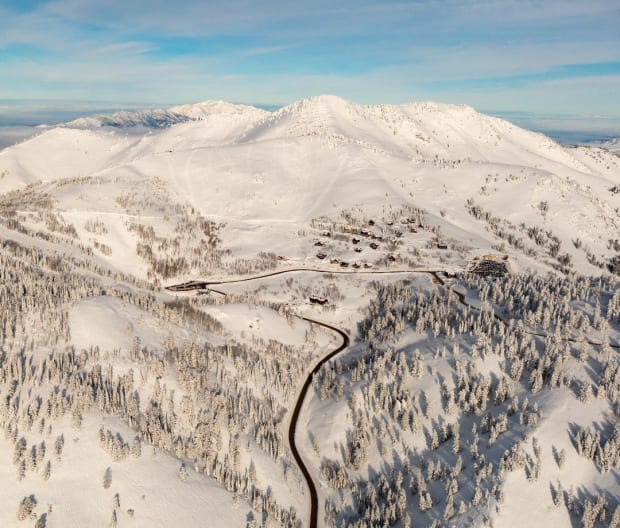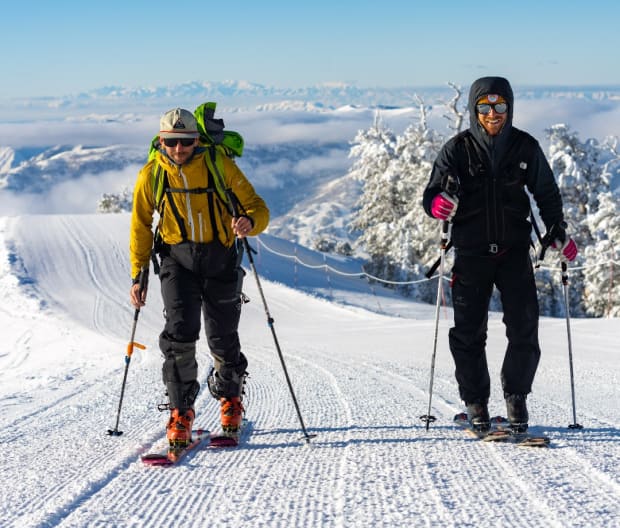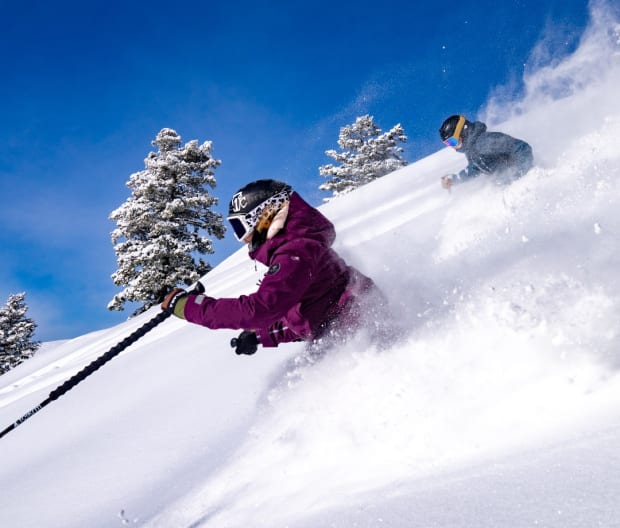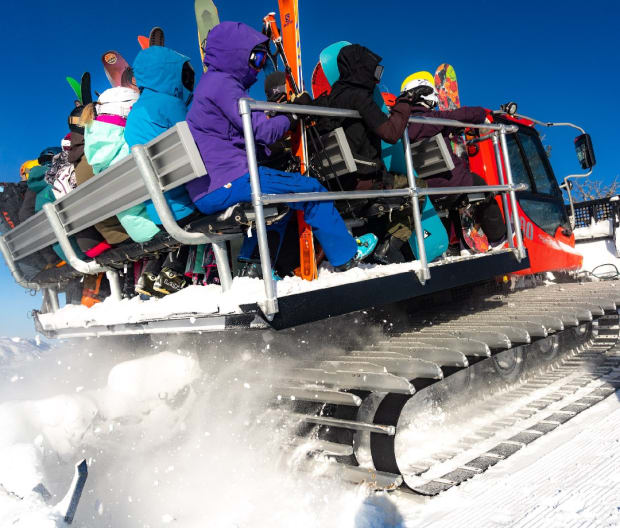Fresh tracks are guaranteed on the vast slopes of aptly-named Powder Mountain, the largest ski resort in the nation by terrain acreage.
It’s no secret that Utah is powder skiing central—especially at favorite knee-deep ski areas like Snowbird, Alta, and Park City. Hiding out of the spotlight (but just an hour up the road form Salt Lake City), aptly named Powder Mountain offers something those other places don’t: extreme room to roam.
With a total ski area of 8,464 acres, Powder Mountain is, in fact, the largest ski resort in America—a factoid buried on the statistics page of this low-key mountain’s website. While other gargantuan ski resorts like Vail, Whistler Blackcomb, and Big Sky can claim far more lifts, mountain infrastructure, and crowds, the scant skiers at Powder Mountain enjoy far more untracked elbow room than anywhere else—and they’re happy to keep it that way.

Ian Matteson
Just ask Jim from Pennsylvania, who we’re riding the Paradise chairlift with after a fresh 18-inch storm. “I absolutely love it here,” says the recent retiree, now dedicated to skiing as much untracked terrain as he possibly can. “I mean, where else can you get powder for days after a storm with no crowds and such a great, low-key vibe?” Jim’s been here for the past seven years, renting a house in nearby Eden from December through April—and the powder-hungry crowds have yet to catch up with him.
The reason is twofold. Powder Mountain’s unending terrain is skied differently than most other resorts. Instead of lapping one lift, the typical protocol here is to lap several, then combine a short snowcat ride to the top ($25 a pop) with a boot hike—before skiing all the way down below the lowest lift to catch a bus back up to base. It’s an entire circuit rather than a single chair ride.
“Sometimes it takes two hours just for a single lap,” says the resort’s marketing director J.P. Goulet. “People get spread out pretty quickly here.”

Ian Matteson
Effective Crowd Control at Powder Mountain, Utah
Unlike the usual big ski resort ethos in today’s Ikon and Epic pass era, Powder Mountain eschews crowds by capping its daily lift ticket sales at just 1,500 per day (and season passes at 3,000), spelling full days of fresh tracks after a storm. Indeed, by our final run, the snow remains far fresher than our legs. On average, the mountain sees only about 150,000 ski days annually [aggregate daily skier visits in a season], says Goulet. This year could top 180,000.
“That’s the most we’ve ever had,” he says.
Combine that with Powder Mountain’s vast acreage and there’s not much reason to farm your turns. By comparison, California’s Mammoth Mountain gets over a million skier visits per year, and Vail Resorts garners a whopping 5.5 million skier and rider days across its five Colorado resorts.
Powder Mountain started capping its daily lift ticket sales seven years ago, “when we saw that the industry was getting over-crowded,” says Goulet, adding that on its busiest days it might see about 2,500 people spread out over its nearly 8,500 acres. “We have awesome, uncrowded skiing in a place where you can always find powder—and we want to preserve that experience,” he adds.

Ian Matteson
A Taste of Snowcat Skiing
In addition to "Pow Mow's" 3,125 acres and 2,205 vertical feet of terrain accessed by nine lifts, it offers an additional 4,832 acres of “lift-accessible terrain,” which is the song and dance we outlined above (lift, snowcat, skinning, bus).
The prime spot for this is via the Lightning Ridge snowcat ride toward the top of 9,422-foot James Peak, giving regular resort skiers a small taste of snowcat skiing. It also has an additional 507 acres of what it calls Adventure Terrain, accessed with a guide, snowcat, or skins.
Celebrating 50 years in 2022, this formula (preserving terrain over ticket sales) keeps its slopes about as uncrowded as they were back in 1972.
Who Owns Powder Mountain
Founded as a small family-run, rope-tow ski hill by the local Cobabe family (which leased the original land for horseback rides and grazing sheep), the “resort” went through two different ownership groups between 2007 and 2013 before being purchased by its current owners, Summit Mountain Holding Group.

Ian Matteson
The latest management has quickly made improvements, including two new chairlifts, upgrading a fleet of passenger snowcats to whisk guests up the ridge toward the top of James Peak, and offering 300 acres of night skiing.
Buses are also available to shuttle skiers and riders back up from the valley below, where the resort’s new Bower Lodge offers a fine après scene. An additional two miles of road now lead to the summit where the resort’s Timberline Lodge Bar and a future lodging project brings up another unique feature of Powder Mountain: lodging options right at the top that will let you wake up and schuss down right after your coffee.

Ian Matteson
Powder Mountain Weather and Average Snowfall
One thing Powder Mountain hasn’t had to invest in at all is snowmaking—relying on its 500-plus inches of annual snowfall. Just a 25-minute drive from Ogden, UT, and an hour from Salt Lake City International Airport, the area is a natural draw for pristine powder seekers like our chairmate, Jim, and others like him. At the end of an epic powder day, I’m still noticing heaps of untracked snow everywhere. But let’s keep that between us.
Where to Stay
Powder Mountain offers a variety of lodging options including cabins, townhomes, houses, and more on the mountain. A variety of B&Bs, lodges, and hotels are also available in the neighboring down-valley communities of Eden, Liberty, and Huntsville. Try Wolf Creek Resort or for a more rustic setting, the Alaskan Inn.
from Men's Journal https://ift.tt/SrOuELJ
via IFTTT
